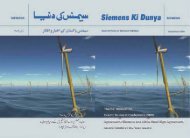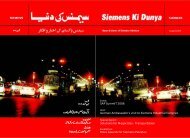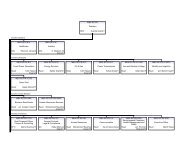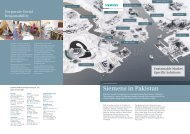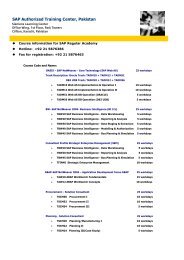Download - Siemens Pakistan
Download - Siemens Pakistan
Download - Siemens Pakistan
Create successful ePaper yourself
Turn your PDF publications into a flip-book with our unique Google optimized e-Paper software.
Notes to the Financial Statements<br />
131<br />
3.6.2 Non-Financial assets<br />
The carrying value of non-financial assets other than inventories and deferred tax assets are assessed at each reporting date to determine whether<br />
there is any indication of impairment. If any such indications exist, then the recoverable amount is estimated. An impairment loss is recognised,<br />
as an expense in the profit and loss account, for the amount by which an asset's carrying amount exceeds its recoverable amount. The recoverable<br />
amount is the higher of an asset's fair value less cost to sell and value in use. Value in use is determined through discounting of the estimated<br />
future cash flows using a discount rate that reflects current market assessments of the time value of money and the risk specific to the assets. For<br />
the purpose of assessing impairment, assets are grouped at the lowest levels for which there are separately identifiable cash flows (cash<br />
generating units).<br />
3.7 Taxation<br />
3.7.1 Current<br />
Provision for current taxation is based on taxability of certain income streams of the Company under presumptive tax regime at the applicable tax<br />
rates and remaining income streams chargeable at current rate of taxation under the normal tax regime after taking into account tax credits and<br />
tax rebates available, if any. The charge for current tax includes adjustments to charge for prior years, if any.<br />
3.7.2 Deferred<br />
Deferred tax is provided using the balance sheet liability method, providing for temporary differences between the carrying amounts of assets and<br />
liabilities for financial reporting purposes and the amounts used for taxation purposes. The amount of deferred tax provided is measured at the<br />
tax rates that are expected to apply to the period when the asset is realised or the liability is settled, based on tax rates and the tax laws that have<br />
been enacted or substantively enacted by the balance sheet date.<br />
A deferred tax asset is recognised only when it is probable that future taxable profits will be available against which the deductible temporary<br />
differences can be utilised. Deferred tax assets are reduced to the extent that it is no longer probable that the related tax benefit will be realised.<br />
3.8 Long-term receivables<br />
Long-term loans, trade receivables, deposits and other receivables, except those on which mark-up is earned by the Company are discounted to<br />
their present values.<br />
3.9 Inventories<br />
Inventories are valued at the lower of cost and net realisable value. Cost of finished goods, both manufactured and purchased, raw material and<br />
components is determined on weighted average basis. The cost of work-in-process and finished goods includes direct materials, labour and<br />
applicable production overheads.<br />
Net realisable value is the estimated selling price in the ordinary course of business, less the estimated costs of completion and selling expenses.<br />
3.10 Trade receivables<br />
3.10.1 Trade receivables are initially recognised at fair value and subsequently measured at amortised cost.<br />
3.10.2 Due against construction work in progress represents the gross unbilled amount expected to be collected from customers for contract work<br />
performed to date. It is measured at cost plus profit recognised to date less progress billing and recognised losses. Cost includes all expenditures<br />
related directly to specific projects and an allocation of fixed and variable overheads incurred.<br />
3.11 Cash and cash equivalents<br />
Cash and cash equivalents comprise of cash in hand, deposits held with banks and highly liquid investments with less than three months maturity<br />
from the date of acquisition. Running finance facilities availed by the Company, which are repayable on demand and form an integral part of the<br />
Company's cash management are included as part of cash and cash equivalents for the purpose of the statement of cash flows.<br />
3.12 Segment reporting<br />
A segment is a distinguishable component of the Company that is engaged in providing related products or services (business segment), or in<br />
providing products or services within a particular economic environment (geographical segment), which is subject to risks and returns that are<br />
different from those of other segments. Segment information is presented in respect of the Company's business and geographical segments. The<br />
Company's primary format for segment reporting is based on business segments. The business segments are determined based on the Company's<br />
management and internal reporting structure.<br />
Segment results, assets and liabilities include items directly attributable to a segment as well as those that can be allocated on a reasonable basis.<br />
Unallocated items comprise mainly investments (other than investment property) and related revenue, loans and borrowings and related<br />
expenses, corporate assets and head office expenses, and income tax assets and liabilities.<br />
Segment capital expenditure is the total cost incurred during the period to acquire property, plant and equipment, and intangible assets other than<br />
goodwill.




